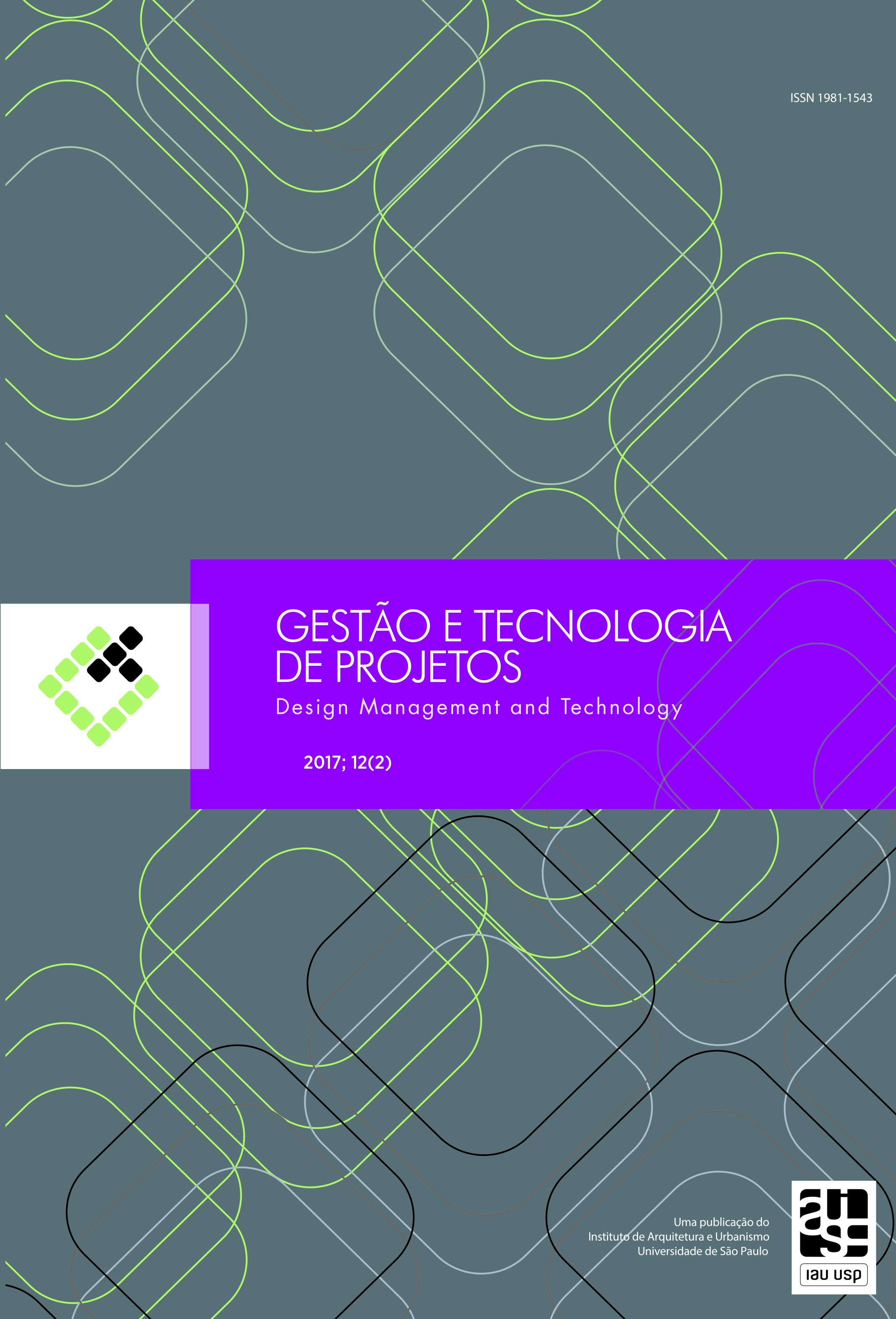A INCORPORAÇÃO DE BIM NO ENSINO DO CURSO TÉCNICO EM EDIFICAÇÕES
DOI:
https://doi.org/10.11606/gtp.v12i2.131498Palavras-chave:
BIM, Ensino, Diagnóstico, Curso Técnico em EdificaçõesResumo
A necessidade de inserir no mercado técnicos qualificados na produçao de modelos de informaçao da construçao, extraçao de dados, detecçao de interferencias e outras açoes relacionadas ao Building Information Modeling (BIM), fez com que a escola Senai Orlando Laviero Ferraiuolo buscasse meios para incorporá-lo ao ensino. Tendo em vista o objetivo de inserçao da formaçao em BIM a nível básico, iniciou-se uma investigaçao das barreiras para a adoçao deste processo no curso e, paralelamente, adotou-se a utilizaçao de estratégias para a incorporaçao do conteúdo em um conjunto abrangente de disciplinas. Neste artigo busca-se relatar o procedimento de diagnóstico das barreiras para adoçao de BIM realizado e o processo simultâneo de açoes para incorporaçao de BIM. Para apoiar este diagnóstico, foi adotado o método de pesquisa etnográfica. Esta investigaçao foi desenvolvida em dois ciclos: no primeiro, aplicou-se o método de diagnóstico de Checcucci, em formato de entrevista em profundidade juntamente com a observaçao participante; no segundo, adaptou-se o método para o formato de levantamento, por meio de um questionário online. Com esta pesquisa foi possível descrever elementos da organizaçao no contexto da incorporaçao de BIM na formaçao do técnico de edificaçoes. Os elementos caracterizados foram a transformaçao na estrutura curricular e a percepçao do corpo docente sobre as barreiras associadas. As contribuiçoes deste trabalho sao o registro do processo e diagnóstico de implementaçao de BIM no curso Técnico em Edificaçoes, as açoes que possibilitaram o amadurecimento do conhecimento dos professores e a adaptaçao do método de Checcucci para diagnóstico da permeabilidade da inserçao de BIM em estruturas curriculares.
Downloads
Referências
BARISON, M. B. Introdução de Modelagem da Informação da Construção (BIM) no currículo: uma contribuição para a formação do projetista. 2015. 387f. Tese (Doutorado em Engenharia de Construção Civil) – Universidade de São Paulo, São Paulo, 2015.
BARISON, M. B.; SANTOS, E. T. Ensino de BIM: tendências atuais no cenário internacional. Gestão e Tecnologia de Projetos, São Carlos, v. 6, n. 2, p. 67-80, 2011.
CÂMARA BRASILEIRA DA INDÚSTRIA DA CONSTRUÇÃO. Implementação do BIM para construtoras e incorporadoras: parte 1: fundamentos BIM. Brasília, DF: CBIC, 2016.
CHECCUCCI, É. S. Ensino-aprendizagem de BIM nos cursos de graduação em engenharia civil e o papel da expressão gráfica neste contexto. 2014. 235f. Tese (Doutorado Multi-institucional e Multidisciplinar em Difusão do Conhecimento) – Faculdade de Educação, Universidade Federal da Bahia, Salvador, 2014.
CHECCUCCI, É. S.; AMORIM, A. L. Método para análise de componentes curriculares: identificando interfaces entre um curso de graduação e BIM. Pesquisa em Arquitetura e Construção, Campinas, v. 5, n. 1, p. 6-17, jan./jun. 2014. Disponível em: <https://goo.gl/B7KBUe>. Acesso em: 17 jan. 2017.
GHAFFARIANHOSEINI, A. et al. Building Information Modelling (BIM) uptake: clear benefits, understanding its implementation, risks and challenges. Renewable and Sustainable Energy Reviews, Amsterdam, v. 75, p. 1046-1053, 2017.
EASTMAN, C. et al. BIM Handbook: a guide to Building Information Modeling for owners, managers, designers, engineers, and contractors. 2. ed. Hoboken: John Wiley & Sons, 2011. 490p.
GIL, A. C. Como elaborar projetos de pesquisa. 5. ed. São Paulo: Atlas, 2010.
KYMMELL, W. Building Information Modeling: planning and managing construction projects with 4D CAD and simulations. New York: McGraw Hill, 2008.
MCGRAW-HILL CONSTRUCTION. The Business value of BIM for construction in major global markets: how contractors around the world are driving innovation with Building Information Modeling. Bedford: McGraw-Hill Construction Research and Analytics, 2014.
PENTTILÄ, H. Describing the changes in architectural information technology to understand design complexity and free-form architectural expression. Journal of Information Technology in Construction, [s.l.], v. 11, p. 395-408, 2006.
RUSCHEL, R. C. To BIM or Not to BIM? In: ENCONTRO DA ASSOCIAÇÃO NACIONAL DE PESQUISA E PÓS‐GRADUAÇÃO EM ARQUITETURA E URBANISMO, 3., 2014, São Paulo. Anais… São Paulo: Universidade Presbiteriana Mackenzie, 2014
RUSCHEL, R. C.; ANDRADE, M. L. V. X.; MORAIS, M. O ensino de BIM no Brasil: onde estamos? Revista Ambiente Construído, Porto Alegre, v. 13, n. 2, p. 151-165, 2013.
SACKS, R.; PIKAS, E. Building Information Modeling education for construction engineering and management: I: industry requirements, state of the art, and gap analysis. Journal of Construction Engineering and Management, Reston, v. 139, n. 11, 2013.
SERVIÇO NACIONAL DE APRENDIZAGEM INDUSTRIAL. Plano de curso técnico em edificações. São Paulo: Senai, 2013. 90p.
SERVIÇO NACIONAL DE APRENDIZAGEM INDUSTRIAL. Plano de curso técnico em edificações. São Paulo: Senai, 2017. 89p.
SUCCAR, B. Building information modeling framework: a research and delivery foundation for industry stakeholders. Automation in Construction, Amsterdam, v. 18, n. 3, p. 357-375, 2009. Disponível em: <https://goo.gl/8UvXAv>. Acesso em: 9 mar. 2017.
SUCCAR, B.; SHER, W.; WILLIAMS, A. Measuring BIM performance: five metrics. Architectural Engineering and Design Management, Abingdon, v. 8, n. 2, p. 120-142, 2012.
Publicado
Edição
Seção
Licença
Autores que publicam nesta revista concordam com os seguintes termos:
- Autores mantém os direitos autorais e concedem à revista o direito de primeira publicação, com o trabalho simultaneamente licenciado sob a Licença Creative Commons Attribution-NonCommercial-NoDerivatives 4.0 que permite o compartilhamento do trabalho com reconhecimento da autoria e publicação inicial nesta revista.
- Autores têm autorização para assumir contratos adicionais separadamente, para distribuição não-exclusiva da versão do trabalho publicada nesta revista (ex.: publicar em repositório institucional ou como capítulo de livro), com reconhecimento de autoria e publicação inicial nesta revista.
- Autores têm permissão e são estimulados a publicar e distribuir seu trabalho online (ex.: em repositórios institucionais ou na sua página pessoal) a qualquer ponto antes ou durante o processo editorial, já que isso pode gerar alterações produtivas, bem como aumentar o impacto e a citação do trabalho publicado (Veja O Efeito do Acesso Livre).








